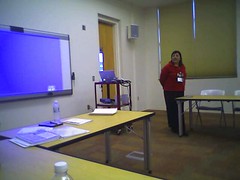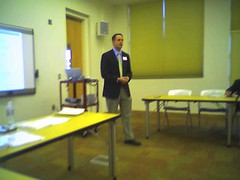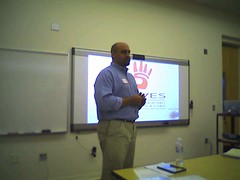This is a Moblog. Please forgive rough text and misspellings.
 I’m sitting in the Friday Institute. More about that later, but we are just beginning a MEGA meetings. More about that later. Dr. Lisa Grable is introducing things, and I just found my way into their wireless network, so I’ll be blogging this in real time. According the Grable, on the day that they opened this center they were the most “wired-up building on the campus.” Only days later, other centers on the campus of North Carolina State University got ideas for enhancing their services, and have since surpassed the Friday Institute.
I’m sitting in the Friday Institute. More about that later, but we are just beginning a MEGA meetings. More about that later. Dr. Lisa Grable is introducing things, and I just found my way into their wireless network, so I’ll be blogging this in real time. According the Grable, on the day that they opened this center they were the most “wired-up building on the campus.” Only days later, other centers on the campus of North Carolina State University got ideas for enhancing their services, and have since surpassed the Friday Institute.
While people are introducting themselves (never know how to introduce myself), they took a handful of us on a tour of the center, which I podcasted. We’ll see more about in Connect Learning.
 Matt Friedrick is going to start the show, entitled “Collaboration in a Flat World”. He is project manager for North Carolina in the World. Kids will be selling to the world and buying from the world. 1,100 companies in NC are doing business internationally.
Matt Friedrick is going to start the show, entitled “Collaboration in a Flat World”. He is project manager for North Carolina in the World. Kids will be selling to the world and buying from the world. 1,100 companies in NC are doing business internationally.
Matt is talking about their program…the goals of their program. I’m not listing them, because they are all very closely aligned with stuff we’re supposed to be teaching already. No surprises, yet!
We’re watching a video now from the Asia Society. It’s a very good video with lots of quotes from state and national leaders.
The limits of what our children learn about their world are their teachers.
What do you think about this statement?
?
Here are some recommendations from the end of the video
- Analyze what’s alreadin in place
- highlight best practices (spread the word)
- develop a plan
- support professional development
- reach out (many businesses have international ties)
- engage parents
Sites
North Carolina has been labeled the most ambitious state in integrating world studies into the curriculum. One of the ideas of the program is to have classrooms from different countries studying the same thing. This is an interesting concept, with much potential, considering accessible video conferencing technologies.
by 2008 every school district in NC will have at least one school in school partnership.
Kim Quinn, one of the people quoted use to be a pig farmer in eastern North Carolina. He saw a need for a special syringe for inoculating livestock. He started a company that now serves 48 states and 27 other countries.
Tom Rabon, of Red Hat, says that it is less important to us what happens in South Carolina or Virginia than what happens in China.
Caroline McCullen just asked how they solved the language barriers. Matt said that there are several answers to that question, but that for the schools they have considered so far, emphasize English. Good thing!
Somebody just asked, “How do you handle timezones!” He said, “badly!” It’s a big problem, but one that indicates our growing international practices.
Another challenging question was about internationalizing mathematics instruction. Matt admitted that math was probably the hardest subject to include in their program. Some ideas were shared by the audience.
 Next is Dr. Len Annetta is a science educator educator. He’s talking about HIFIVES – highly interactive fun internet virtual environments in science. As Len started to approach folks with strategies for using technology in science instruction, he suggested that they use video games. People didn’t like the idea. But then when he suggested HIFIVES, they bought in. They like acronyms more than they like video games.
Next is Dr. Len Annetta is a science educator educator. He’s talking about HIFIVES – highly interactive fun internet virtual environments in science. As Len started to approach folks with strategies for using technology in science instruction, he suggested that they use video games. People didn’t like the idea. But then when he suggested HIFIVES, they bought in. They like acronyms more than they like video games.
Len is going through some slides. I’ll ask if they’re on line. But I just saw an interesting term, Stealth Learning. Can wait to learn what that means. It means, “Kids learn something without knowing their learning.
He’s showing a game that his class created, but I wonder where the game is. There were some interesting graphics and 3D environments, but I didn’t see the game. What is a game? What is it about games that draw kids and and keep them? What are the elements of a success video game? Are their consistent elements? I imagine I’d have to take the class.
He just demonstrated their next version will use Second Life II VR engine. He set up a virtual chair, and then with a cross-bow, shot helium balloons at the chair until there were enough to raise the the chair.
Roger Stack is commenting on this blog, as I write it. If he gives me his AOL IM screen name, perhaps we can chat.

Fantasitic David – I feel I have my personal on-the-spot ed-correspondent! You do the work and I sit comfortably sipping coffee in Australia reaping the benefits… Great web sites – just what I need for a project I’m working on.
Not too many limits to my learning here 🙂
I’m still with you… 🙂
I’m researching the terms you mention while you add to the blog… lots of press releases on HIFIVES… and some interesting links on Stealth Learning – particularly in gaming… perhaps we should be communicating via Messenger then I could feed you background research and you could ask tricky questions 🙂
If you hear anything about research mapping what thinking/problem solving skills different games at different levels help develop please post it…
I’m fascinated by this real-time blogging experience… thanks!
Gotta go… meeting someone for a beach walk… will leave by the back door so I don’t disturb anyone… 😉
(Please delete MSN and AOL comments above)
You know my views on the world being flat and I would be wary of basing a theses on that assumption; I’d be very interested to hear about that session in more depth. I’m coming round to the idea that, in the US perhaps, things are appearing flatter in the same way as you can see the ships coming into Marseilles when stood in Nice thanks to an optical illusion of the sun: i.e. a beautiful site on the horizon but, still, you’re actually just in Nice.
As for teachers being the barrier to learning in an international knowledge economy: yes, often. But it’s nothing new. The problem is you can’t go to these teachers and tell them that nor are they the kind of teachers that are likely to change their practice overnight to accommodate ‘our’ strategies (and that’s how they see these strategies, as belonging to one person or a small group, but not to them). How can these strategies become more widely accepted?
Ewan,
I’ve not read your views on Flatism. I would now, but no time. I’m itching for a write 😉
I suspect that much of the world scratches their heads about Friedman’s, The World is Flat. I agree that it is a largely U.S. illusion, but we are the audience, by and large. We’re accustomed to thinking of the world as hilly — one really big hill, a few smaller ones, and then lots of deep, dark, and largely insignificant valleys. That’s changed, and what’s dangerous is that we (U.S.) seem not to have noticed, or what we notice seems, somehow, unfair. Friedman states toward the end of his book, that the world certainly is not flat, that there remain valleys that we should, frankly, be ashamed of. ..and some of them are in my country. The world is not flat, but the mountains and valleys are surely shifting, and it’s something that the “what” and “how” we teach and learn seems to be ignoring.
Matt Friedrick’s presentation was much more about facilitating international cooperations in North Carolina classrooms, than flatism. He actually mentioned the book only once. My opinion is that he is, by FAR, not being ambitious enough. Their 2008 goal, though ambitious in terms of what we might expect from a lumbering education system, would not significantly impact that many children, that many decisions, that many careers. Their goal should be to see parents, when talking with each other at the club or at the Laundromat, asking each other, “So, with what classrooms around the world are your children learning at school.”
I think that as long as we forgive our schools, school leaders, and governance for moving slowly, things will not speed up.
But hey, I’m a radical 😉
I don’t think what you’ve said is radical at all. Perhaps because of the proximity of different cultures in Europe our students have an inceasingly large number of connections with classrooms abroad. In Musselburgh, for example, I helped run around 20 links last year. And the parents do talk about it in the fish and chip shop queue, or at the parents’ evenings. It’s been a big thrill and I can only encourage more international links to take place. Ironically, it is the links with parents that are the most difficult to establish as they are not always as interested in education as teachers and students in classrooms abroad.